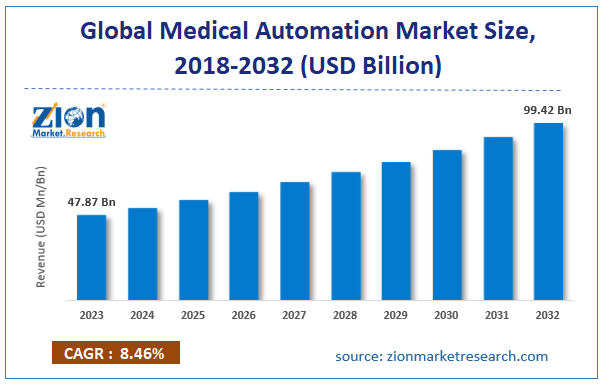Medical Automation Market Trend, Share, Growth, Size and Forecast 2032
The medical automation market is rapidly expanding as healthcare systems worldwide increasingly adopt automated technologies to improve efficiency, accuracy, and patient outcomes. Medical automation involves the use of automated systems and devices in various healthcare processes, from diagnosis and treatment to patient monitoring and administrative tasks.

Get a Free Sample : https://www.zionmarketresearch.com/sample/medical-automation-market
Key Market Drivers:
- Growing Demand for Minimally Invasive Surgeries: The increasing preference for minimally invasive procedures, which often rely on automated systems like robotic surgery, is a significant driver of the medical automation market. These procedures offer benefits such as reduced recovery times and lower risks of complications.
- Shortage of Healthcare Workers: With the global shortage of healthcare professionals, automation helps alleviate the burden on existing staff by handling routine and repetitive tasks, allowing healthcare providers to focus on more complex patient care activities.
- Technological Advancements: Continuous innovations in robotics, artificial intelligence (AI), machine learning, and the Internet of Things (IoT) are enhancing the capabilities of medical automation systems, driving their adoption across healthcare settings.
- Rising Healthcare Costs: Automation helps reduce healthcare costs by improving operational efficiency, reducing errors, and enabling remote monitoring and telemedicine, which can decrease the need for in-person visits and hospital stays.
Market Trends:
- Robotic Surgery: The use of robotic systems in surgery is one of the fastest-growing segments in medical automation. These systems enhance precision, reduce human error, and improve patient outcomes, making them increasingly popular in various surgical specialties.
- Automated Diagnostics and Lab Automation: Automation in diagnostic labs, including the use of automated analyzers and sample handling systems, is improving the speed and accuracy of diagnostic tests while reducing labor costs and human error.
- AI in Healthcare: AI is being integrated into various aspects of healthcare, from diagnostic imaging and drug discovery to personalized medicine and predictive analytics. AI-driven automation is transforming how diseases are diagnosed and treated.
- Patient Monitoring and Telemedicine: Automated systems for remote patient monitoring, often integrated with telemedicine platforms, are enabling continuous health monitoring and management, particularly for chronic disease patients and elderly populations.
Challenges:
- High Initial Costs: The upfront costs of acquiring and implementing advanced automation systems can be high, particularly for smaller healthcare facilities and in developing regions.
- Regulatory and Safety Concerns: Ensuring the safety and reliability of automated medical systems is critical, and navigating the regulatory environment for these devices can be complex and time-consuming.
- Resistance to Change: There can be resistance to adopting automation among healthcare professionals who are accustomed to traditional methods, particularly when it comes to tasks involving direct patient care.
Market Outlook:
The medical automation market is expected to grow at a compound annual growth rate (CAGR) of approximately 8-10% over the next few years. The growth is driven by the increasing demand for automated solutions in healthcare, technological advancements, and the ongoing shift towards more efficient, cost-effective healthcare delivery.
Major Players:
Key companies in the medical automation market include Siemens Healthineers, GE Healthcare, Philips Healthcare, Medtronic, Stryker Corporation, and Intuitive Surgical. These companies are investing heavily in research and development, forming strategic partnerships, and expanding their product offerings to maintain a competitive edge.
Regional Insights:
- North America: The largest market for medical automation, driven by advanced healthcare infrastructure, significant investment in healthcare technology, and a strong focus on improving patient outcomes.
- Europe: A mature market with growing demand for automation in healthcare, particularly in countries with aging populations and high healthcare costs.
- Asia-Pacific: The fastest-growing region, with rising healthcare expenditure, expanding healthcare infrastructure, and increasing adoption of advanced technologies driving market growth.
The medical automation market is set for significant growth as healthcare systems continue to embrace automation to improve efficiency, reduce costs, and enhance the quality of care.
Contact :
US OFFICE NO +1 (302) 444-0166
US/CAN TOLL FREE +1 (855) 465-4651
Email: sales@zionmarketresearch.com

Comments
Post a Comment